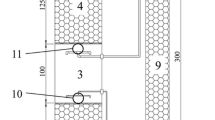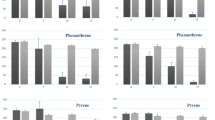Abstract
The degradation of polychlorinated biphenyls (PCBs) was investigated under fermentative-methanogenic conditions for up to 60 days in the presence of anaerobic biomass from a full-scale UASB reactor. The low methane yields in the PCBs-spiked batch reactors suggested that the biomass had an inhibitory effect on the methanogenic community. Reactors containing PCBs and co-substrates (ethanol/sodium formate) exhibited substantial PCB reductions from 0.7 to 0.2 mg mL−1. For the Bacteria domain, the PCBs-spiked reactors were grouped with the PCB-free reactors with a similarity of 55 %, which suggested the selection of a specific population in the presence of PCBs. Three genera of bacteria were found exclusively in the PCB-spiked reactors and were identified using pyrosequencing analysis, Sedimentibacter, Tissierela and Fusibacter. Interestingly, the Sedimentibacter, which was previously correlated with the reductive dechlorination of PCBs, had the highest relative abundance in the RCS-PCB (7.4 %) and RCS-PCB-PF (12.4 %) reactors. Thus, the anaerobic sludge from the UASB reactor contains bacteria from the Firmicutes phylum that are capable of degrading PCBs.





Similar content being viewed by others
References
Abramowicz DA (1995) Aerobic and anaerobic PCB biodegradation in the environment. Environ Health Perspect 103:97–99
Angelidaki I, Petersen SP, Ahring BK (1990) Effects of lipids on thermophilic anerobic digestion and reduction of lipid inhibition upon addition of bentonite. Appl Microbiol Biotechnol 33:469–472
APHA (2005) Standard methods for the examination of water and wastewater, 21st edn. American Public Health Association, Washington, D.C
Baba D, Katayama A (2007) Enhanced anaerobic biodegradation of polychlorinated biphenyls in burnt soil culture. J Biosci Bioeng 104:62–68
Borja J, Taleon DM, Auresenia J, Gallardo S (2005) Polychlorinated biphenyls and their biodegradation. Process Biochem 40:1999–2013
Breitenstein A, Wiegel J, Haertig C, Weiss N, Andreesen JR, Lechner U (2002) Reclassification of Clostridium hydroxybenzoicum as Sedimentibacter hydroxybenzoicus gen. nov., comb. nov., and description of Sedimentibacter saalensis sp. nov. Int J Syst Evol Microbiol 52:801–807
Chu Y, Wei Y, Yuan X, Shi X (2011) Bioconversion of wheat stalk to hydrogen by dark fermentation: effect of different mixed microflora on hydrogen yield and cellulose solubilisation. Bioresour Technol 102:3805–3809
Cutter LA, Watts JE, Sowers KR, May HD (2001) Identification of a microorganism that links its growth to the reductive dechlorination of 2,3,5,6- chlorobiphenyl. Environ Microbiol 3:699–709
Erickson MD, Kaley RG II (2011) Applications of polychlorinated biphenyls. Environ Sci Pollut Res 18:135–151
Field JA, Serra-Alvarez R (2008) Microbial transformation and degradation of polychlorinated biphenyls. Environ Pollut 155:1–12
Furukawa K, Fujihara H (2008) Microbial degradation of polychlorinated biphenyls: biochemical and molecular features. J Biosci Bioeng 105:433–449
Griffiths RI, Whiteley AS, O’Donnell AG (2000) Rapid method for coextraction of DNA and RNA from natural environments for analysis of ribosomal DNA and rRNA-based microbial community composition. Appl Environ Microbiol 66:5488–5491
Hou L, Dutta SK (2000) Phylogenetic characterization of several para- and meta-PCB dechlorinating Clostridium species: 16S rDNA sequence analyses. Lett Appl Microbiol 30:238–243
Kaneko T, Nakamura Y, Sato S, Minamisawa K, Uchiumi T, Sasamoto S, Watanabe A, Idesawa K, Iriguchi M, Kawashima K, Kohara M, Matsumoto M, Shimpo S, Tsuruoka H, Wada T, Yamada M, Tabata S (2002) Complete genomic sequence of nitrogen-fixing symbiotic bacterium Bradyrhizobium japonicum USDA110. DNA Res 9:189–197
Kudo Y, Nakajima T, Miyaki T, Oyaizu H (1997) Methanogen flora of paddy soils in Japan. FEMS Microbiol Ecol 22:39–48
Lawrence J, Tosine HM (1976) Adsorption of polychlorinated biphenyls from aqueous solutions and sewage. Environ Sci Technol 10:381–383
Leigh MB, Pellizari VH, Uhlik O, Sutka R, Rodrigues J, Ostrom NE, Zhou J, Tiedje JM (2007) Biphenyl-utilizing bacteria and their functional genes in a pine root zone contaminated with polychlorinated biphenyls (PCBs). ISME J 1:134–148
Liu Y, Whitman WB (2008) Metabolic, phylogenetic, and ecological diversity of the methanogenic Archaea. Ann NY Acad Sci 1125:171–189
Liu W, Sun Z, Zhang J, Gao W, Wang W, Wu L, Sun T, Chen W, Liu X, Zhang H (2009) Analysis of microbial composition in acid whey for dairy fan making in yunnan by conventional method and 16S rRNA sequencing. Curr Microbiol 59:199–205
Muyzer G, De Waal EC, Uitterlinden AG (1993) Profiling of complex microbial populations by denaturing gradient gel electrophoresis analysis of polymerase chain reaction amplified genes encoding for 16S rRNA. Appl Environ Microbiol 59:695–700
Nübel U, Engelen B, Felske A, Snaidr J, Wieshuber A, Amann RI, Ludwig W, Backhaus H (1996) Sequence heterogeneities of genes encoding 16S rRNAs in Paenibacillus polymyxa detected by temperature gradient gel electrophoresis. J Bacteriol 178:5636–5643
Nunez AE (2008). Microbial community structure dynamics in Ohio river sediments during reductive dechlorination of PCBs. Dissertation, University of Kentucky. http://uknowledge.uky.edu/gradschool_diss/679
Obst M, Krug A, Luftmann H, Steinbüchel A (2005) Degradation of cyanophycin by Sedimentibacter hongkongensis strain KI and Citrobacter amalonaticus strain G isolated from an anaerobic bacterial consortium. Appl Environ Microbiol 71:3642–3652
Onodera-Yamada K, Morimoto M, Tani Y (2001) Degradation of dibenzothiophene by sulfate-reducing bacteria cultured in the presence of only nitrogen gas. J Biosci Bioeng 91:91–93
Penteado ED, Lazaro CZ, Sakamoto IK, Zaiat M (2013) Influence of seed sludge and pretreatment method on hydrogen production in packed-bed anaerobic reactors. Int J Hydrogen Energ 38:6137–6145
Plugge CM, Henstra AM, Worm P, Swarts DC, Paulitsch-Fuchs AH, Scholten JCM, Lykidis A, Lapidus AL, Goltsman E, Kim E, McDonald E, Rohlin L, Crable BR, Gunsalus RP, Stams AJM, McInerney MJ (2012) Complete genome sequence of Syntrophobacter fumaroxidans strain (MPOBT). Stand Genomics Sci 7:91–106
Qiu YL, Hanada S, Ohashi A, Harada H, Kamagata Y, Sekiguchi Y (2008) Syntrophorhabdus aromaticivorans gen. nov., sp. nov., the first cultured anaerobe capable of degrading phenol to acetate in obligate syntrophic associations with a hydrogenotrophic methanogen. Appl Environ Microbiol 74:2051–2058
Ravot G, Magot M, Fardeau ML, Patel BKC, Thomas P, Garcia JL, Ollivier B (1999) Fusibacter paucivorans gen. nov., sp. nov., an anaerobic, thiosulfate-reducing bacterium from an oil-producing well. Int J Syst Bacteriol 49:1141–1147
Ribani M, Grespan CB, Collins CH, Jardim ICSF (2004) Validation for chromatographic and electrophoretic methods. Quim Nova 27:771–780
Saia FT, Damianovic MHRZ, Cattony EBM, Brucha G, Foresti E, Vazoller RF (2007) Anaerobic biodegradation of pentachlorophenol in a fixed-film reactor inoculated with polluted sediment from Santos-São Vicente Estuary, Brazil. Appl Microbiol Biotechnol 75:665–672
Sung Y, Fletcher KE, Ritalahti KM, Ramos-Hernández N, Sanford RA, Mesbah NM, Löffler FE (2006) Geobacter lovleyi strain SZ sp. nov., a novel metal-reducing and tetrachloroethene-dechlorinating bacterium. Appl Environ Microbiol 72:2775–2782
Vishnivetskaya TA, Brandt CC, Madden AS, Drake MM, Kostka JE, Akob DM, Kusel K, Palumbo AV (2010) Microbial community changes in response to ethanol or methanol amendments for U(VI) reduction. Appl Environ Microbiol 76:5728–5735
Xu M, Chen X, Qiu M, Zeng X, Xu J, Deng D, Sun G, Li X, Guo J (2012) Bar-coded pyrosequencing reveals the responses of PDBE-degrading microbial communities to electron donor amendments. PLoS One 7:e30439
Yamada T, Sekiguchi Y, Hanada S, Imachi H, Ohashi A, Harada H, Kamagata Y (2006) Anaerolinea thermolimosa sp. nov., Levilinea saccharolytica gen. nov., sp. nov. and Leptolinea tardivitalis gen. nov., sp. nov., novel filamentous anaerobes, and description of the new classes Anaerolineae classis nov. and Caldilineae classis nov. in the bacterial phylum Chloroflexi. Int J Syst Evol Microbiol 56:1331–1340
Yang Y, McCarty PL (1998) Competition for hydrogen within a chlorinated solvent dehalogenating anaerobic culture. Environ Sci Technol 32:3591–3592
Zanaroli G, Negroni A, Vignola M, Nuzzo A, Shu H-Y, Fava F (2012) Enhancement of microbial reductive dechlorination of polychlorinated biphenyls (PCBs) in a marine sediment by nanoscale zerovalent iron (NZVI) particles. J Chem Technol Biotechnol 87:1246–1253
Zhang T, Shao M-F, Ye L (2012) 454 Pyrosequencing reveals bacterial diversity of activated sludge from 14 sewage treatment plants. ISME J 6:1137–1147
Acknowledgments
B.C. Gomes thanks the National Council for Scientific and Technological Development (CNPq) for the fellowship grant (150339/2012-7).
Author information
Authors and Affiliations
Corresponding author
Electronic supplementary material
Below is the link to the electronic supplementary material.
Rights and permissions
About this article
Cite this article
Gomes, B.C., Adorno, M.A.T., Okada, D.Y. et al. Analysis of a microbial community associated with polychlorinated biphenyl degradation in anaerobic batch reactors. Biodegradation 25, 797–810 (2014). https://doi.org/10.1007/s10532-014-9700-7
Received:
Accepted:
Published:
Issue Date:
DOI: https://doi.org/10.1007/s10532-014-9700-7




